The concept of pack leader dog training has been a source of debate for years. Some trainers advocate for a dominance-based approach, emphasizing the human’s role as the pack leader. However, recent advancements in animal behavior science paint a different picture. This article will explore the origins of pack leader theory, delve into its effectiveness, and offer alternative methods for building a positive and harmonious relationship with your canine companion.
Contents
- The Rise (and Fall) of Pack Leader Theory
- The Science of Positive Reinforcement
- Building a Relationship, Not a Hierarchy
- Essential Elements for Effective Dog Training
- Addressing Common Dog Behavior Problems
- Finding the Right Trainer
- Seeking professional guidance when necessary
- Beyond Training: Building a Fulfilling Life Together
The Rise (and Fall) of Pack Leader Theory
The idea of humans assuming the role of the alpha dog stems from early observations of wolves in captivity. These studies, however, were flawed. Captive wolf packs often form artificial social structures that don’t reflect those of wild wolves. Additionally, wolves and dogs are not identical species. Dogs have been selectively bred for companionship for millennia, resulting in significant behavioral differences.
Despite these shortcomings, the idea of dominance-based training gained traction. Trainers used techniques like alpha rolls (dominating a dog by pinning it to the ground) and leash corrections to establish themselves as the leader. However, these methods are not only harsh but often counterproductive. They can damage the bond between human and dog, leading to increased anxiety and fear in the animal.

The Science of Positive Reinforcement
Modern dog training emphasizes positive reinforcement. This approach focuses on rewarding desired behaviors, building trust and motivation in the dog. Positive reinforcement has been proven to be highly effective, leading to faster learning and a happier dog.
Here’s how positive reinforcement works: When your dog exhibits a positive behavior, such as sitting on command, you reward them with a treat, praise, or a toy. This creates a positive association between the behavior and the reward. Over time, the dog is more likely to repeat the desired behavior to earn the reward.

Building a Relationship, Not a Hierarchy
The concept of a human being a dog’s “pack leader” implies a dominance hierarchy. However, the relationship between humans and dogs is more akin to a partnership. Dogs are social creatures who crave our attention and interaction. By providing clear expectations, consistent training, and positive reinforcement, we can build a strong bond with our canine companions.

Essential Elements for Effective Dog Training
- Clear Communication: Dogs learn best from clear and consistent cues. Use short, distinct commands and pair them with positive reinforcement. For example, consistently say “sit” before rewarding your dog for sitting.
- Patience and Consistency: Learning takes time. Be patient with your dog and remain consistent with your training methods. Don’t give up if your dog doesn’t get it right away.
- Positive Reinforcement: Reward desired behaviors with treats, praise, or playtime. This will motivate your dog to learn and repeat the desired behavior.
- Socialization: Expose your dog to different people, places, and other animals from a young age. This will help them become well-adjusted and comfortable in various situations.
- Management: Prevent unwanted behaviors by managing your dog’s environment. For example, use a crate or baby gates to confine your dog when you can’t supervise them.
Addressing Common Dog Behavior Problems
Many dog owners struggle with specific behavior problems, such as excessive barking, chewing, housebreaking, or leash pulling. Here’s how positive reinforcement can help:
- Barking: Identify the cause of the barking (e.g., boredom, anxiety, seeking attention) and address it. Train your dog a “quiet” command and reward them for being quiet.
- Chewing: Provide your dog with plenty of appropriate chew toys and redirect them to these toys when they start chewing on something unwanted.
- Housebreaking: Take your dog out frequently, especially after meals, playtime, and waking up. Reward them for eliminating outdoors.
- Leash Pulling: Use a positive reinforcement training method called loose leash walking. Reward your dog for walking calmly beside you with slack in the leash.

Finding the Right Trainer
If you’re looking for help with your dog’s behavior, seek out a qualified positive reinforcement trainer. Look for trainers who use force-free methods and prioritize building a positive relationship between humans and dogs. Ask about their experience and training methods before scheduling a session.
Seeking professional guidance when necessary
Recognizing when you need help is a sign of strength and good judgment. There are several factors to consider when deciding if seeking professional guidance is the right move:
- Complexity of the Issue: If you’re facing a problem that feels overwhelming or beyond your current knowledge, a professional can offer expertise and tailored solutions.
- Lack of Progress: Have you been trying to solve the issue on your own for a while with no improvement? A professional can provide a fresh perspective and different approaches.
- Negative Impact on Well-Being: Is the issue causing significant stress, anxiety, or impacting your daily life? Seeking professional help can improve your overall well-being.
- Sensitive Topics: Sometimes, issues like mental health or legal matters require specialized knowledge and support that a professional can provide.
Here are some resources for finding professional guidance:
- Therapists/Counselors: For mental health concerns, a therapist or counselor can offer support and guidance. Many insurance plans cover therapy sessions.
- Financial Advisors: Need help with managing finances or investing? A financial advisor can create a personalized plan based on your goals.
- Lawyers: Facing legal issues? A lawyer can advise you on your rights and represent you in court if necessary.
- Trainers: Whether it’s dog training, fitness training, or professional development, a qualified trainer can help you achieve your goals.
- Online Resources: Many professional organizations and government websites offer resources and information on various topics.
Remember, seeking professional guidance is not a sign of weakness. It’s a proactive step towards finding solutions and improving your life.

Beyond Training: Building a Fulfilling Life Together
Positive reinforcement dog training goes beyond teaching commands. It’s about fostering communication, trust, and a strong bond with your dog. Provide your dog with plenty of exercise, mental stimulation, and opportunities to engage in their natural instincts. For example, take your dog on walks, play fetch, or teach them nosework games.
By focusing on positive reinforcement, clear communication, and building a strong relationship, you can create a harmonious and fulfilling life with your canine companion. Forget the outdated pack leader mentality; embrace a partnership based on mutual respect and love.


